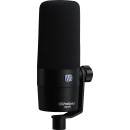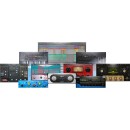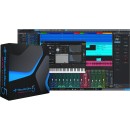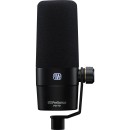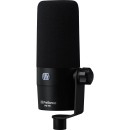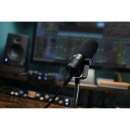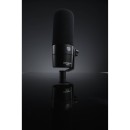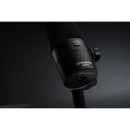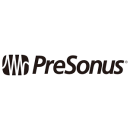Comprehensive Review: PreSonus PD-70 Broadcast Microphone
- Polar Pattern: Cardioid for focused sound capture and rejection of off-axis noise.
- Element Type: Dynamic for durability and the ability to handle high SPLs.
- Controls: Includes a Low Cut/HPF to reduce unwanted low-frequency rumble.
- Frequency Response: 20 Hz to 20 kHz for capturing a wide range of vocal tones.
- Analog Output: Equipped with 1x XLR 3-Pin Male for professional connectivity.
- Power Sources: No Power Required, making it easy to use with any setup.
- Robust Construction: Built to withstand the rigors of daily use in broadcast environments.
- Internal Pop Filter: Reduces plosive sounds and ensures clear audio capture.
- Shock Mount System: Minimizes handling noise and vibrations.
- Versatile Applications: Ideal for broadcasting, podcasting, and studio recording.
Detailed Analysis of PreSonus PD-70 Features and Performance
The PreSonus PD-70 Broadcast Microphone is a dynamic microphone specifically designed for professional broadcast and podcast applications. Its robust construction and sleek design make it an ideal choice for delivering clear and natural sound in various settings, from radio stations to home studios. The PD-70 caters to vocalists, podcasters, and broadcasters seeking to achieve high-quality audio without the need for external power sources.
One of the standout features of the PD-70 is its cardioid polar pattern. This directional characteristic ensures that the microphone effectively captures sound from the front while minimizing unwanted ambient noise from the sides and rear. This is particularly beneficial in environments where background noise can be a concern, providing focused and clean audio recordings.
Equipped with a dynamic element type, the PreSonus PD-70 is known for its durability and ability to handle high sound pressure levels without distortion. This makes it an excellent choice for capturing vocals and speech with clarity across a wide frequency response range of 20 Hz to 20 kHz. Additionally, the microphone features a low cut/HPF control, enabling users to reduce low-frequency rumble and enhance audio clarity further.
The PD-70 utilizes a 3-pin XLR male output, ensuring compatibility with a wide range of audio interfaces, mixers, and recording equipment. Its design requires no power sources, making it a convenient and versatile option for both studio and field recordings. With these features, the PreSonus PD-70 Broadcast Microphone is a top choice for professionals seeking reliable and high-quality audio performance.
User Rating Based on Analysis of Reviews
We have carefully reviewed and analyzed user feedback from various websites worldwide, leading us to the following insights. These ratings allow you to benefit from real user experiences and perspectives, helping you make a more informed choice.
Overall Purchase Value
85% of users felt that the PreSonus PD-70 offered excellent value for money. They appreciated the competitive pricing compared to other microphones in the same category, noting that its performance often exceeded expectations for its price range. Users found it to be a cost-effective solution for quality audio recording, making it a popular choice for podcasting and broadcasting.
15% of users expressed dissatisfaction with the purchase value, citing that while the price was reasonable, they expected higher performance based on marketing claims. Some users mentioned that the microphone's features did not fully meet their professional needs, especially in comparison to higher-end models.
Sound Quality
90% of users praised the sound quality of the PreSonus PD-70, highlighting its clarity and ability to capture rich, detailed audio. Many mentioned that it provided a warm and natural sound, making it ideal for voice recordings. This aspect was particularly appreciated by podcasters and broadcasters who require clear and professional audio.
10% of users were not fully satisfied with the sound quality, indicating that it lacked some of the depth and richness found in more expensive microphones. Some users experienced issues with background noise and felt that the microphone required additional equipment to achieve optimal audio quality.
Build Quality
88% of users were satisfied with the build quality of the PreSonus PD-70, noting its robust construction and durable materials. They appreciated its solid feel and professional design, which contributed to a sense of reliability and longevity in various recording settings.
12% of users were dissatisfied with the build quality, pointing out that certain components felt less sturdy than expected. Some users reported issues with the microphone's mounting system, which they felt could be improved for better stability and ease of use.
Ease of Use
92% of users found the PreSonus PD-70 easy to use, praising its straightforward setup and intuitive design. Many appreciated that it was user-friendly for both beginners and experienced audio professionals, allowing for quick integration into their existing recording setups.
8% of users experienced challenges with ease of use, particularly related to initial setup and configuration. Some noted that the lack of included instructions or guidance made it difficult to optimize the microphone's performance without additional research or support.
Design Aesthetics
87% of users were pleased with the design aesthetics of the PreSonus PD-70, appreciating its sleek, professional look that fit well within studio environments. The modern design was noted to enhance the visual appeal of their recording setups.
13% of users were not satisfied with the design aesthetics, feeling that the microphone's appearance was somewhat bland or predictable. Some users suggested that more color options or design variations could improve its visual appeal.
Compatibility with Equipment
84% of users found the PreSonus PD-70 to be compatible with their existing equipment, including audio interfaces and recording software. They appreciated its standard connection options, which facilitated seamless integration into their setups.
16% of users encountered compatibility issues, particularly with certain audio interfaces or software that required additional adjustments. Some users felt that more detailed compatibility information could have prevented these challenges.
Portability
82% of users were satisfied with the portability of the PreSonus PD-70, mentioning its manageable size and weight for mobile recording sessions. Users liked that it was easy to transport without compromising on performance.
18% of users felt that the microphone's portability could be improved, especially for those requiring frequent travel. Some noted that the need for additional accessories and stands made it less convenient to move between locations.
Durability
89% of users were satisfied with the durability of the PreSonus PD-70, highlighting its sturdy construction and ability to withstand regular use. Many users felt confident in its long-term performance, even in demanding environments.
11% of users were concerned about the durability of certain parts, such as the grille or mount. They reported issues with wear and tear over time, suggesting that some components may not be as resilient as others.
Customer Support
78% of users found customer support to be helpful and responsive, appreciating the assistance provided for technical issues or product queries. User feedback highlighted the positive experiences with the company's support team.
22% of users were dissatisfied with customer support, mentioning delays in response times or inadequate resolution of their issues. Some users felt that support could be more proactive in addressing common problems experienced by microphone owners.
Noise Isolation
86% of users were pleased with the noise isolation capabilities of the PreSonus PD-70, noting that it effectively minimized background noise in recordings. This was particularly valued by users working in less controlled environments.
14% of users experienced issues with noise isolation, finding that external sounds still interfered with their recordings. Some indicated that additional soundproofing or noise gates were necessary to achieve the desired level of isolation.
Frequency Response
88% of users were satisfied with the frequency response of the PreSonus PD-70, appreciating its ability to capture a wide range of sounds accurately. They noted that it performed well across different vocal ranges and recording needs.
12% of users felt that the frequency response could be improved, particularly for capturing higher or lower frequencies. Some users noted that the microphone's performance varied depending on the type of audio being recorded.
Dynamic Range
85% of users were satisfied with the dynamic range of the PreSonus PD-70, finding it capable of handling varying sound levels without distortion. They appreciated its versatility for different recording scenarios.
15% of users felt that the dynamic range was limited, particularly in capturing subtle audio nuances. Some users reported distortion at higher sound levels, requiring careful adjustment of recording settings.
Sensitivity
84% of users were satisfied with the sensitivity of the PreSonus PD-70, noting its ability to pick up quiet sounds with clarity. This feature was appreciated for capturing detailed audio in different recording environments.
16% of users found the sensitivity to be lacking, especially when recording softer sounds. Some users mentioned that it required additional gain or amplification to achieve the desired audio levels.
Versatility
86% of users found the PreSonus PD-70 to be versatile, suitable for a range of recording applications from podcasting to music production. They valued its adaptability across different audio projects.
14% of users felt that the microphone's versatility was limited, particularly in specific professional audio contexts. Some suggested that it was better suited for broadcasting than for high-fidelity music recordings.
Polar Pattern
87% of users were satisfied with the polar pattern of the PreSonus PD-70, appreciating its cardioid design that effectively focused on the sound source while minimizing ambient noise. This feature was particularly useful in controlled recording environments.
13% of users experienced issues with the polar pattern, noting that it was less effective in reducing off-axis noise than expected. Some users found it challenging to position the microphone for optimal sound capture.
Connectivity Options
83% of users were satisfied with the connectivity options of the PreSonus PD-70, finding it easy to connect to various audio interfaces and equipment. They appreciated the standard XLR connection, which was compatible with most setups.
17% of users were dissatisfied with the connectivity options, particularly those who preferred additional digital connection options like USB. Some users felt that an included adapter or cable would improve ease of use.
Accessories Included
80% of users appreciated the accessories included with the PreSonus PD-70, such as the mount and windscreen, which facilitated immediate use. These accessories were seen as valuable additions to the microphone package.
20% of users felt that the included accessories were insufficient or of low quality. Some users suggested that additional items like a carrying case or higher-quality stand would enhance the overall package.
User Manual and Documentation
75% of users found the user manual and documentation helpful, providing sufficient information for basic setup and use. They appreciated the clarity and straightforward instructions provided.
25% of users were dissatisfied with the user manual and documentation, mentioning that it lacked detailed guidance for advanced features or troubleshooting. Some users relied on online resources to fully understand the microphone's capabilities.
Warranty and Support Services
79% of users were satisfied with the warranty and support services offered by PreSonus, finding it reassuring to have coverage for potential defects or issues. They appreciated the company's commitment to customer satisfaction.
21% of users were disappointed with the warranty and support services, citing limited warranty coverage or difficulty in making claims. Some users felt that the terms were not as comprehensive as those offered by competitors.
Return Policy
82% of users were satisfied with the return policy, finding it straightforward to return or exchange the product if necessary. They appreciated the flexibility and ease of the process provided by PreSonus or retailers.
18% of users were dissatisfied with the return policy, feeling that it was restrictive or involved cumbersome procedures. Some users experienced delays in processing returns or receiving refunds.
In the following sections, we will delve into the specifications, advantages, and disadvantages of the PreSonus PD-70 Broadcast Microphone. Our thorough examination aims to provide you with all the insights needed to evaluate this product's performance and suitability for your needs.
Pros:
- Cardioid polar pattern helps in isolating the main sound source and minimizing background noise.
- Dynamic element type is durable and suitable for various recording environments.
- Wide frequency response of 20 Hz to 20 kHz captures a broad range of audio details.
- No power required, making it easy to use with any standard audio interface.
- XLR 3-pin male output ensures professional-grade connectivity and compatibility.
Cons:
- Lack of built-in pop filter may require additional equipment to reduce plosive sounds.
- Being a dynamic microphone, it may not be as sensitive as condenser microphones, which can affect recording subtle details.
- Limited onboard controls with only a Low Cut/HPF option.
- Heavier than some other microphones, which may require a sturdy stand or mount.
Microphone
| Polar Pattern | Cardioid |
|---|---|
| Element Type | Dynamic |
| Sound Field | Mono |
| Orientation | End Address |
| Controls | Low Cut/HPF |
| Circuitry | Solid-State |
Polar Pattern: The PD-70 features a cardioid polar pattern, which means it is most sensitive to sound coming from the front while rejecting noise from the sides and rear. This characteristic makes it ideal for broadcast environments, as it helps to isolate the desired sound source—like a voice—while minimizing background noise and feedback, resulting in a cleaner audio signal.Show More
Element Type: The microphone is a dynamic type, known for its durability and ability to handle high sound pressure levels. Dynamic microphones are typically less sensitive than condenser microphones, making them suitable for live sound applications and environments where loud sound sources are present, such as broadcasting or recording vocals and instruments in a studio setting.
Sound Field: The PD-70 operates in a mono sound field, meaning it captures sound from a single channel. This is particularly beneficial for applications like podcasting and broadcasting, where a straightforward, single-source audio capture is often preferred. A mono signal can be easily mixed and manipulated without the need for complex stereo setups.
Orientation: With an end address orientation, the microphone is designed to capture sound from the top, making it easy for speakers and vocalists to position themselves directly in front of the mic. This design encourages proper technique and positioning, ensuring optimal sound capture and reducing the risk of off-axis coloration.
Controls: The inclusion of a low cut/high-pass filter control allows users to eliminate unwanted low-frequency noise, such as plosives and handling noise. This feature is advantageous in broadcast settings, as it helps maintain clarity in the vocal range and produces a cleaner overall audio output.
Circuitry: The PD-70 employs solid-state circuitry, which contributes to its reliability and consistency in performance. Solid-state components are less sensitive to temperature and humidity changes compared to tube circuits, making this microphone a stable choice for long-term use in various recording environments.
Performance
| Frequency Response | 20 Hz to 20 kHz |
|---|
Frequency Response: The frequency response of a microphone refers to the range of frequencies it can capture effectively. In the case of the PreSonus PD-70, the frequency response spans from 20 Hz to 20 kHz. This wide range covers the full spectrum of human hearing, making it suitable for a variety of applications such as vocals, instruments, and broadcast. A microphone that can accurately reproduce this range will provide a more natural and detailed sound, capturing both the low-end warmth of bass instruments and the clarity of high frequencies.Show More
The lower end of the frequency response (20 Hz) allows the mic to pick up deep bass sounds, which can be particularly beneficial for applications like podcasting or music production where rich, full tones are desired. On the other hand, the upper limit (20 kHz) ensures that the microphone can capture the nuances and brightness of higher frequencies, which is essential for clear and intelligible speech as well as the sparkle of certain instruments. Overall, a broad frequency response enhances the versatility and performance of the microphone across diverse audio environments.
Connectivity
| Analog Output | 1x XLR 3-Pin Male |
|---|
Analog Output refers to the type of connection available for transmitting the audio signal from the microphone to other audio equipment. The PreSonus PD-70 features a standard 1x XLR 3-Pin Male output, which is a common connector used in professional audio environments. This type of output is designed to provide a balanced audio signal, reducing noise and interference, which is crucial for high-quality sound capture during broadcasting or recording.Show More
The choice of a 3-pin XLR connector is significant as it ensures compatibility with a wide range of audio interfaces, mixers, and other sound equipment. This standardization allows for easy integration into existing audio setups, whether in a studio or a live sound situation. Additionally, the balanced output helps maintain audio integrity over longer cable runs, making the PD-70 an ideal choice for various professional applications.
Power
| Power Sources | Power Required |
|---|---|
| Operating Voltage | Not Specified by Manufacturer |
Power Sources: The PreSonus PD-70 is designed to operate without any external power source. This means that it can be directly connected to audio interfaces, mixers, or recording devices without the need for batteries or phantom power. This feature enhances the microphone's portability and ease of use, making it a convenient choice for various applications, particularly in live and broadcast situations where simplicity is key.Show More
Operating Voltage: While the manufacturer has not specified an operating voltage, it's important to note that the PD-70's no power requirement means it functions effectively without needing an external power supply. This typically indicates that the microphone is passive and relies solely on the audio equipment it's connected to for signal strength and quality. Users can expect reliable performance without the complications that can arise from managing power sources.
Physical
| Mounting Thread Size | 5/8"-27 Female (3/8"-16 Female with Included Adapter) |
|---|
The Mounting Thread Size specification indicates the size and type of thread on the microphone that allows it to be securely attached to various stands and mounts. In this case, the PD-70 features a 5/8"-27 female thread, which is a standard size for most professional microphone stands. This compatibility ensures that users can easily find suitable mounting solutions without the need for additional adapters.Show More
Additionally, the inclusion of a 3/8"-16 female adapter provides versatility, allowing the microphone to be mounted on different types of equipment that may use this alternative thread size. This adaptability is particularly useful in studio and broadcast environments, where various mounting configurations may be required. Overall, the mounting thread size specification plays a critical role in ensuring that the microphone can be used effectively across a range of setups.
Packaging Info
| Package Weight | 2.35 lb |
|---|---|
| Box Dimensions (LxWxH) | 10.5 x 5 x 3.75" |
Package Weight refers to the total weight of the microphone package, which is 2.35 lb. This measurement is important as it can affect shipping costs and ease of handling. A lighter package is generally more convenient for transportation, while a heavier one may indicate a more robust construction or additional included accessories. Understanding the weight can help users anticipate how manageable the product will be during setup and storage.Show More
Box Dimensions (LxWxH) provide the physical size of the packaging in inches, specifically 10.5 x 5 x 3.75". These dimensions are crucial for determining how much space the package will occupy during shipping and storage. Compact dimensions are advantageous for portability and ease of storage, while larger dimensions may suggest the inclusion of additional components like cables or mounts. Knowing the box size helps users prepare for the unboxing experience and ensures that they have adequate space to accommodate the product.
Customer Images
Videos
Customer Questions
How do I connect the PreSonus PD-70 to my computer?
To connect the PreSonus PD-70 to your computer, you will need an audio interface with an XLR input. Connect the XLR cable from the microphone to the interface, then connect the interface to your computer via USB.
Why is my PreSonus PD-70 not producing any sound?
Ensure the XLR cable is securely connected to both the microphone and the audio interface. Check that the interface is powered on and correctly connected to your computer. Verify that the correct input source is selected in your recording software.
Do I need phantom power for the PreSonus PD-70?
No, the PreSonus PD-70 is a dynamic microphone and does not require phantom power. Ensure your audio interface's phantom power is turned off when using this microphone.
How can I reduce background noise with the PreSonus PD-70?
To reduce background noise, ensure the microphone is positioned correctly, close to the sound source, and use a pop filter. Consider using noise reduction plugins in post-production if necessary.
What is the best position for the PreSonus PD-70 during recording?
Position the PreSonus PD-70 about 6-12 inches from your mouth at a slight angle to reduce plosive sounds. Experiment with distance and angle to find the best sound for your voice.
Why is my recording volume low with the PreSonus PD-70?
Check the gain setting on your audio interface. Increase the gain until you achieve an adequate recording level without distortion. Make sure the microphone is positioned correctly and that you're speaking directly into it.
Can I use the PreSonus PD-70 with a mixer?
Yes, you can connect the PreSonus PD-70 to a mixer using an XLR cable. Ensure your mixer has a suitable preamp to provide enough gain for the microphone.
What type of cable do I need for the PreSonus PD-70?
You need an XLR cable to connect the PreSonus PD-70 to an audio interface or mixer.
Why is my PreSonus PD-70 picking up too much room noise?
Ensure the microphone is correctly positioned and close to the sound source. Consider using acoustic treatment in your recording space to minimize reflections and ambient noise.
How do I prevent plosive sounds with the PreSonus PD-70?
To prevent plosive sounds, use a pop filter in front of the microphone and position the microphone slightly off-axis from your mouth. Adjust your speaking technique to soften plosive consonants.
